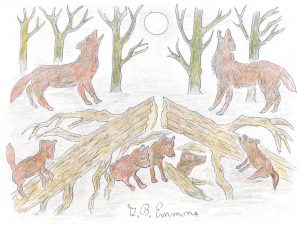The Eastern coyote that we often see darting across both country and suburban roads in the nocturnal headlights of our car has come to be as large as a German Shepherd dog. We have become aware that they are not the same at all as the small 25-pound western, wily, animated humorous character in Walt Disney cartoons for children. When and how did that happen? Today, scientists are in considerable disagreement on how the process of hybridization was greatly accelerated by human modification to habitat that in turn paved the way for geographical adjustment to all of New England.
The original Southwest species was perhaps best characterized in Navaho folklore as a trickster involved in the mythology of life’s first creation on Earth, claiming mystical superiority in the scheme of how it all came about. Now, he has miraculously transformed himself in the mind of civilization from being first a coyote, then into a ‘coydog,’ and now about to be reclassified as a ‘coywolf.’ The taxonomy of this new species often labeled back yard big game is currently estimated as approximately 60 percent coyote, 30 percent wolf, and as much as 10 percent domestic dog, even though interbreeding with them is rare.
There is some possibility that they will continue to evolve into a new species, Canis oriens, because of success highlighted by genetic findings of ability to interbreed with other canines as well as readily adapt to the too-close-for-comfort inter-city habitat. They can run 40 miles per hour, travel long distances daily up to 15 miles, with a lifetime range of 11 square miles, frequently relocating to other areas to their liking. They adapt quickly to a wide variety of food including rabbits, woodchucks, rodents, wild turkeys and other birds, feral cats, stray small pets, and dogs. At the last den I personally have found was a wide variety of bits of fir and feather, including traces of white tail deer fawns.
Mainly nocturnal, they can be out of most people’s sight and mind, but audibly they communicate with each other with short barks for location of others. They are very social and family-preoccupied, as I recently observed in a recently mowed farm field with a mother standing on her hind feet showing her pups how to find and ferret out a rodent. They are better known for howling more often at a rising full moon as in my illustration. It starts out with a flat tone, followed by a wavering blood curdling howl conveyed to others in the distance.
Perhaps alarming to the peace and quiet of mortal ears, it is also a message of environmental awareness to human beings in this day and age of modern times around Buzzards Bay.
By George B. Emmons

Nice article George. I’ve been studying their behavior for many years, paying particular attention to their vocalizations. I like how you’ve picked up on the short barks they use to stay in touch while hunting separately for small game. The pack howls are more common in winter when they gather for deer hunts.